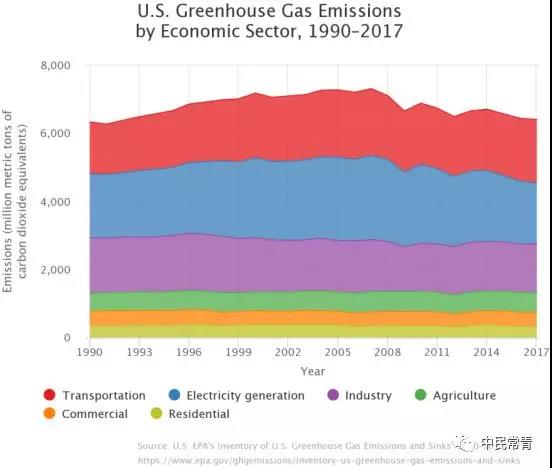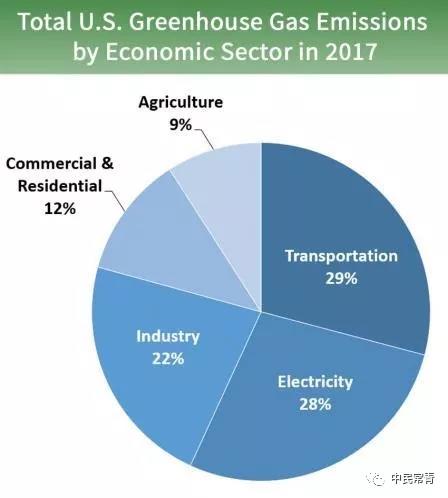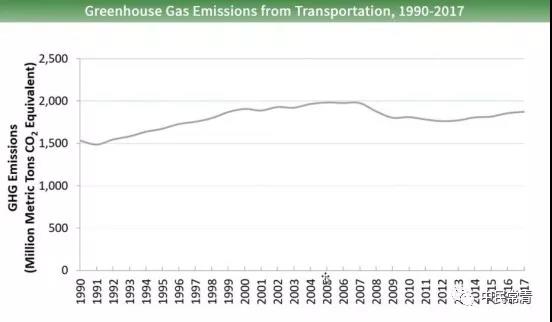
碳交易手机客户端
新闻产生价值 资讯挖掘商机
美国环保署:2017年美国温室气体排放量同比下降0.5%;电力行业下降4.2%,交通行业增长1.21%
碳道小编 · 2019-04-19 07:04 · 阅读量 · 3716
摘要:美国环保署清单所涵盖的气体包括:二氧化碳、甲烷、一氧化二氮、氢氟烃、全氟化碳、六氟化硫和三氟化氮。该清单还计算了“碳汇”,例如通过吸收碳和储存在森林、植被和土壤中,从大气中去除的二氧化碳排放量。
根据美国环境保护署(EPA) 2019年温室气体(GHG)排放年度报告,2017年美国温室气体排放量同比下降0.5%(扣除土地部门的封存),电力部门排放量同比下降4.2%。

减少的主要原因是化石燃料燃烧排放的减少,这是多种因素共同作用的结果,包括煤炭向天然气持续过渡,电力部门可再生能源的使用增加,以及温和的天气导致整体用电量减少。
2017年,美国温室气体排放总量为64.567亿吨二氧化碳当量(扣除土地部门的封存),相当于574.26亿吨二氧化碳当量。2005年以来,全国温室气体排放下降13%,电力行业排放下降27.6%。
在美国2017年的温室气体排放中,交通运输业的温室气体排放量占最大份额,为28.9%。超过90%的交通用燃料是以石油为基础的,主要包括汽油和柴油。
2016年至2017年,交通运输终端行业二氧化碳排放增长1.21%。排放量的小幅增加是由于中型和重型卡车柴油燃料消耗量的增加和商用飞机喷气燃料消耗量的增加。

从总体趋势来看,从1990年到2017年,交通总排放量增加,这在很大程度上是由于旅游需求的增加。1990年至2017年,轻型汽车(乘用车和轻型卡车)行驶里程(VMT)增长45.9%,这是人口增长、经济增长、城市扩张和低油价时期等因素综合作用的结果。
在1990年至2004年间,随着轻型卡车销量的增加,新车的平均燃油经济性逐年下降。从2005年开始,新车平均燃油经济性开始上升,而轻型车辆行驶里程在此期间的大部分时间里仅小幅增长。自2005年以来,新车的平均燃油经济性几乎每年都在提高,2016年,卡车在新车中的份额约为45%。

美国环保署清单所涵盖的气体包括:二氧化碳、甲烷、一氧化二氮、氢氟烃、全氟化碳、六氟化硫和三氟化氮。该清单还计算了“碳汇”,例如通过吸收碳和储存在森林、植被和土壤中,从大气中去除的二氧化碳排放量。
本年度报告由美国环保署与美国能源部能源信息管理局、美国国防部和农业部等其他联邦机构的众多专家合作编写;以及国家政府部门;研究及学术机构;和行业协会。
—以下附上原英文文章—
Year-over-year, US greenhouse gas emissions were 0.5% lower in 2017 than the prior year (after accounting for sequestration from the land sector), and power sector emissions fell 4.2%, according to the 2019 edition of the US Environmental Protection Agency’s (EPA) annual report on greenhouse gas (GHG) emissions.
This decrease was largely driven by a decrease in emissions from fossil fuel combustion, which was a result of multiple factors including a continued shift from coal to natural gas and increased use of renewables in the electric power sector, and milder weather that contributed to less overall electricity use.
In 2017, US greenhouse gas emissions totaled 6,456.7 million metric tons of carbon dioxide equivalents, or 5,742.6 million metric tons of carbon dioxide equivalents after accounting for sequestration from the land sector.
Since 2005, national greenhouse gas emissions have fallen by 13%, and power sector emissions have fallen by 27.6%.
The transportation sector now generates the largest share of greenhouse gas emissions in the US—28.9% of 2017 greenhouse gas emissions. More than 90% of the fuel used for transportation is petroleum-based, which includes primarily gasoline and diesel.
From 2016 to 2017, CO2 emissions from the transportation end-use sector increased by 1.21%. The small increase in emissions is attributed to an increase in diesel fuel consumption by medium- and heavy-duty trucks and jet fuel consumption by commercial aircraft.
In terms of the overall trend, from 1990 to 2017, total transportation emissions have increased due, in large part, to increased demand for travel. The number of vehicle miles traveled (VMT) by light-duty motor vehicles (passenger cars and light-duty trucks) increased by 45.9% from 1990 to 2017, as a result of a confluence of factors including population growth, economic growth, urban sprawl, and periods of low fuel prices.
Between 1990 and 2004, average fuel economy among new vehicles sold annually declined, as sales of light-duty trucks increased. Starting in 2005, average new vehicle fuel economy began to increase while light-duty VMT grew only modestly for much of the period. Average new vehicle fuel economy has improved almost every year since 2005, and the truck share is about 45% of new vehicles in model year 2016.
The gases covered by the EPA inventory include: carbon dioxide, methane, nitrous oxide, hydrofluorocarbons, perfluorocarbons, sulfur hexafluoride and nitrogen trifluoride. The inventory also calculates carbon dioxide emissions that are removed from the atmosphere by “sinks,” e.g., through the uptake of carbon and storage in forests, vegetation and soils.
This annual report is prepared by EPA in collaboration with numerous experts from other federal agencies including the US Department of Energy’s Energy Information Administration, US Department of Defense and US Department of Agriculture; state government authorities; research and academic institutions; and industry associations.
— END —
来源:中民常青